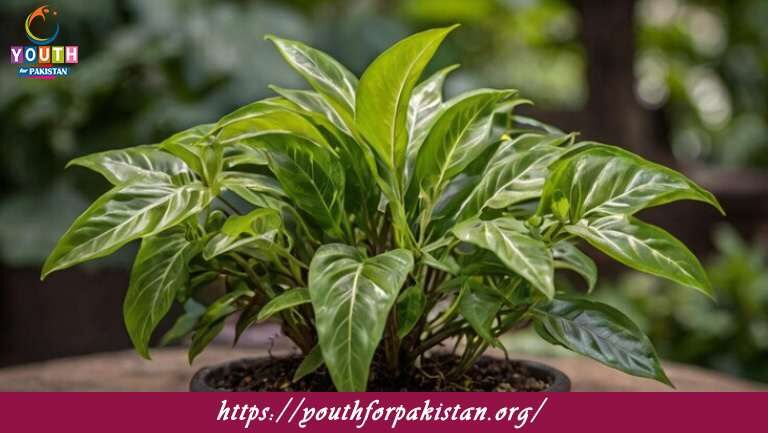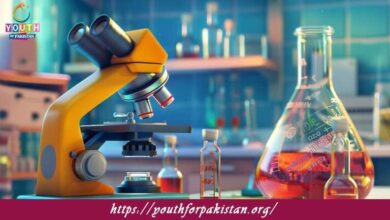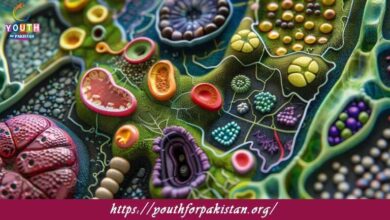11th Class Biology Chapter 9 MCQs with Answers

Explore plant diversity with 11th Class Biology Chapter 9 MCQs Kingdom Plantae MCQs covering classification, plant structures, and reproduction. Chapter 9 quizzes are tailored for 11th Class Biology students to strengthen your understanding of the plant kingdom.
Which kingdom do plants belong to?
a) Kingdom Animalia
b) Kingdom Protista
c) Kingdom Plantae
d) Kingdom Fungi
Plants are classified as:
a) Prokaryotes
b) Eukaryotes
c) Archaea
d) Bacteria
The process by which green plants use sunlight to synthesize food from carbon dioxide and water is known as:
a) Photosynthesis
b) Respiration
c) Transpiration
d) Fermentation
The primary pigment responsible for capturing sunlight during photosynthesis is:
a) Chlorophyll a
b) Chlorophyll b
c) Carotenoids
d) Xanthophylls
Which of the following is not a plant organ?
a) Leaf
b) Root
c) Stem
d) Stamen
The waxy layer on the surface of the plant leaves that helps reduce water loss is called:
a) Epidermis
b) Cuticle
c) Stoma
d) Mesophyll
The specialized cells on plant leaves that regulate gas exchange are called:
a) Epidermal cells
b) Guard cells
c) Xylem cells
d) Phloem cells
The tissue responsible for transporting water and nutrients throughout the plant is called:
a) Epidermis
b) Parenchyma
c) Xylem
d) Phloem
The process by which water and nutrients are absorbed by the roots and transported to other parts of the plant is known as:
a) Photosynthesis
b) Respiration
c) Transpiration
d) Osmosis
The male reproductive part of a flower is called the:
a) Stigma
b) Style
c) Anther
d) Ovary
The female reproductive part of a flower is called the:
a) Stigma
b) Style
c) Anther
d) Ovary
The process of transferring pollen from the anther to the stigma is known as:
a) Fertilization
b) Pollination
c) Germination
d) Photosynthesis
The process of joining male and female gametes to initiate seed formation is called:
a) Fertilization
b) Pollination
c) Germination
d) Photosynthesis
The structure that encloses and protects the developing seeds in a flowering plant is called:
a) Stamen
b) Petal
c) Sepal
d) Fruit
The process by which a seed begins to grow into a new plant is called:
a) Fertilization
b) Pollination
c) Germination
d) Photosynthesis
Which of the following is not a type of plant tissue?
a) Meristematic tissue
b) Epidermal tissue
c) Mesodermal tissue
d) Ground tissue
The plant tissue responsible for photosynthesis is called:
a) Meristematic tissue
b) Epidermal tissue
c) Ground tissue
d) Mesophyll tissue
The outermost layer of a plant’s stem and root is known as the:
a) Epidermis
b) Cortex
c) Xylem
d) Phloem
The main function of the root is to:
a) Photosynthesize
b) Absorb water and nutrients
c) Conduct photosynthesis
d) Produce flowers
The main function of the stem is to:
a) Absorb water and nutrients
b) Store food
c) Anchor the plant to the ground
d) Transport water and nutrients
The main function of leaves is to:
a) Absorb water and nutrients
b) Store food
c) Anchor the plant to the ground
d) Conduct photosynthesis
The process of shedding leaves from a plant is called:
a) Germination
b) Photosynthesis
c) Transpiration
d) Abscission
The type of plant tissue responsible for secondary growth (increasing the girth of stems and roots) is called:
a) Meristematic tissue
b) Epidermal tissue
c) Vascular tissue
d) Cork cambium
The group of plants that lack vascular tissues (xylem and phloem) and are typically small and simple in structure are known as:
a) Angiosperms
b) Gymnosperms
c) Pteridophytes
d) Bryophytes
Mosses and liverworts are examples of:
a) Angiosperms
b) Gymnosperms
c) Pteridophytes
d) Bryophytes
The group of plants that includes conifers and cycads, and often produces seeds in cones, is known as:
a) Angiosperms
b) Gymnosperms
c) Pteridophytes
d) Bryophytes
The group of plants that includes ferns and horsetails and reproduces using spores is known as:
a) Angiosperms
b) Gymnosperms
c) Pteridophytes
d) Bryophytes
The group of plants that includes flowering plants and is the largest and most diverse group of plants on Earth is known as:
a) Angiosperms
b) Gymnosperms
c) Pteridophytes
d) Bryophytes
The specialized structure in angiosperms where seeds are formed after fertilization is called the:
a) Ovary
b) Anther
c) Petal
d) Stamen
The outermost whorl of floral organs in angiosperms, usually green and leaf-like, is called the:
a) Sepal
b) Petal
c) Stamen
d) Pistil
The male reproductive part of a flower, consisting of the filament and anther, is called the:
a) Sepal
b) Petal
c) Stamen
d) Pistil
The female reproductive part of a flower, consisting of the stigma, style, and ovary, is called the:
a) Sepal
b) Petal
c) Stamen
d) Pistil
The fusion of pollen grains with the stigma of a flower is the first step of:
a) Pollination
b) Fertilization
c) Germination
d) Photosynthesis
Double fertilization, a unique process in angiosperms, involves the formation of:
a) Two seeds in a single ovule
b) Two embryos in a single seed
c) Two endosperms in a single seed
d) Two zygotes in a single ovule
The process by which seeds develop into new plants is called:
a) Pollination
b) Fertilization
c) Germination
d) Photosynthesis
The specialized structure in gymnosperms where seeds are formed after fertilization is called the:
a) Ovary
b) Anther
c) Petal
d) Cone
The group of plants that includes pine trees, spruces, and firs and typically produces seeds in cones is known as:
a) Angiosperms
b) Gymnosperms
c) Pteridophytes
d) Bryophytes
The group of plants that includes cycads, ginkgo, and conifers and lacks flowers and fruits is known as:
a) Angiosperms
b) Gymnosperms
c) Pteridophytes
d) Bryophytes
The primary type of tissue in vascular plants that transports sugars and other organic compounds throughout the plant is called:
a) Xylem
b) Phloem
c) Epidermis
d) Meristem
The primary type of tissue in vascular plants that transports water and minerals from the roots to the rest of the plant is called:
a) Xylem
b) Phloem
c) Epidermis
d) Meristem
The process by which water and nutrients move upward through the xylem in plants is known as:
a) Transpiration
b) Photosynthesis
c) Translocation
d) Respiration
The process by which sugars and other organic compounds move through the phloem in plants is known as:
a) Transpiration
b) Photosynthesis
c) Translocation
d) Respiration
The type of root system in which a main taproot is present, with smaller lateral roots branching off, is called:
a) Adventitious root system
b) Fibrous root system
c) Tuberous root system
d) Propagative root system
The type of root system in which numerous thin roots of similar size spread out from the base of the stem is called:
a) Adventitious root system
b) Fibrous root system
c) Tuberous root system
d) Propagative root system
The type of root system in which a swollen root stores food and water, often found in plants like sweet potatoes, is called:
a) Adventitious root system
b) Fibrous root system
c) Tuberous root system
d) Propagative root system
The type of root system that develops from non-root plant parts, such as stems or leaves, is called:
a) Adventitious root system
b) Fibrous root system
c) Tuberous root system
d) Propagative root system
The type of plant tissue responsible for growth in length (primary growth) is called:
a) Vascular tissue
b) Dermal tissue
c) Meristematic tissue
d) Ground tissue
The type of plant tissue responsible for growth in width (secondary growth) is called:
a) Vascular tissue
b) Dermal tissue
c) Meristematic tissue
d) Ground tissue
The tissue that covers the outer surface of the plant and protects it from damage and water loss is called:
a) Xylem
b) Phloem
c) Epidermis
d) Meristem
The specialized tissue responsible for growth in plants, found in the tips of roots and stems, is called:
a) Xylem
b) Phloem
c) Epidermis
d) Meristem
The growth that occurs in plants due to cell division in the apical meristem is called:
a) Primary growth
b) Secondary growth
c) Tertiary growth
d) Quaternary growth
The growth that occurs in plants due to cell division in the lateral meristem is called:
a) Primary growth
b) Secondary growth
c) Tertiary growth
d) Quaternary growth
The process of shedding leaves, flowers, or fruits from a plant is called:
a) Abscission
b) Transpiration
c) Pollination
d) Germination
The group of plants that includes grasses, grains, and orchids and is the most diverse group of land plants is known as:
a) Gymnosperms
b) Bryophytes
c) Pteridophytes
d) Angiosperms
The group of plants that typically produce seeds in a cone and include pine trees, spruces, and firs is known as:
a) Angiosperms
b) Bryophytes
c) Gymnosperms
d) Pteridophytes
The group of plants that includes ferns and horsetails and reproduces using spores is known as:
a) Angiosperms
b) Bryophytes
c) Gymnosperms
d) Pteridophytes
The group of plants that lacks vascular tissues (xylem and phloem) and includes mosses and liverworts is known as:
a) Angiosperms
b) Bryophytes
c) Gymnosperms
d) Pteridophytes
The specialized structure in angiosperms where seeds are formed after fertilization is called the:
a) Ovary
b) Anther
c) Petal
d) Cone
The male reproductive part of a flower, consisting of the filament and anther, is called the:
a) Sepal
b) Petal
c) Stamen
d) Pistil
The female reproductive part of a flower, consisting of the stigma, style, and ovary, is called the:
a) Sepal
b) Petal
c) Stamen
d) Pistil
If you are interested to enhance your knowledge regarding Physics, Chemistry, Biology, and Computer please click on the link of each category, you will be redirected to dedicated website for each category.





